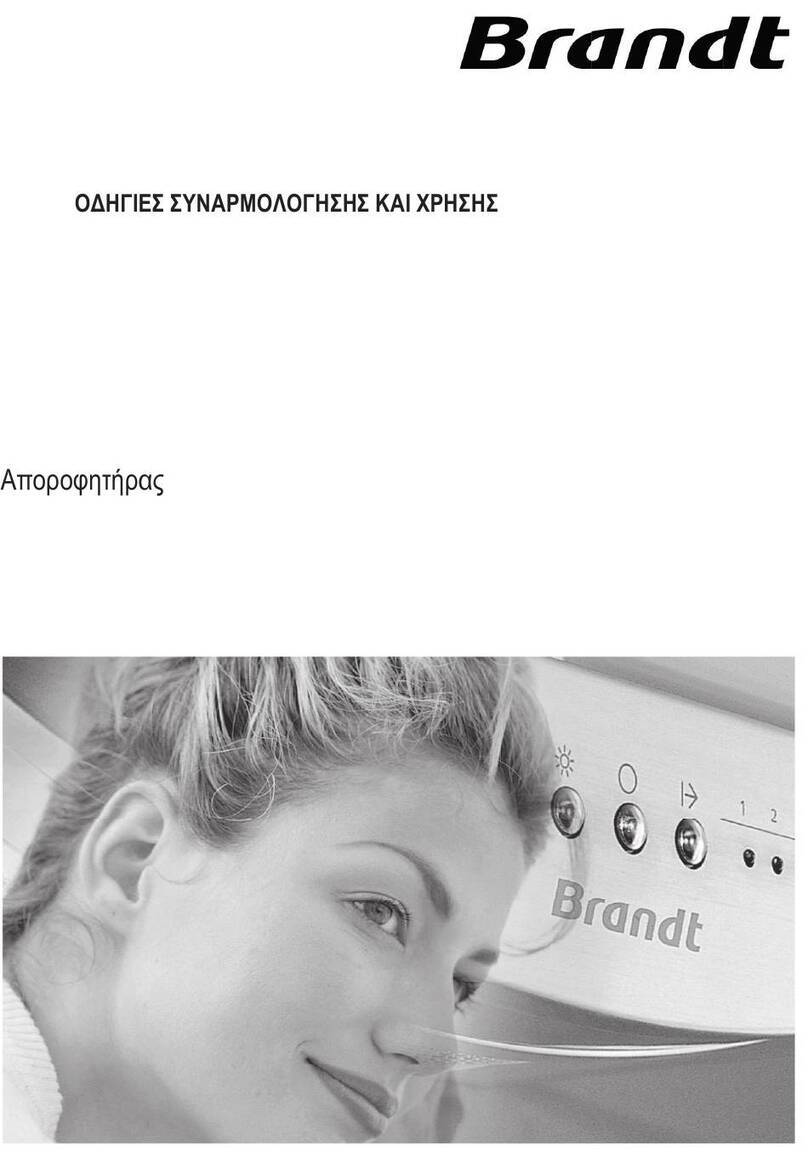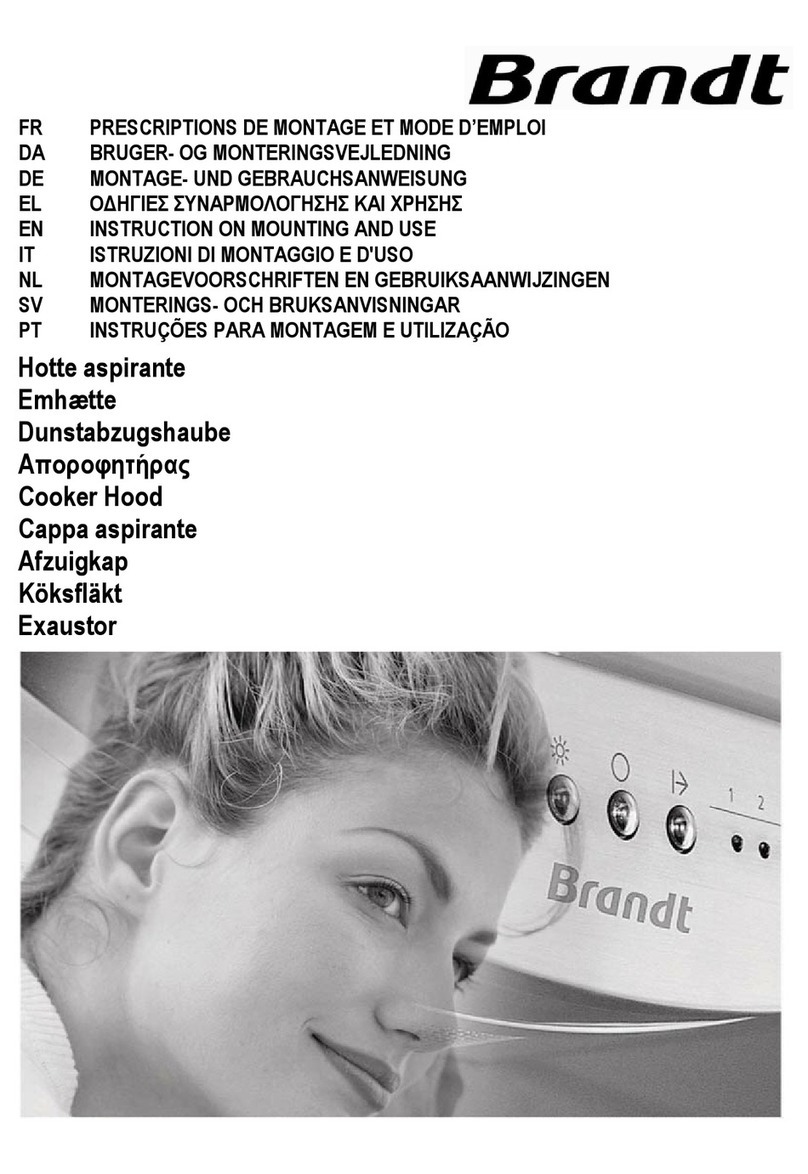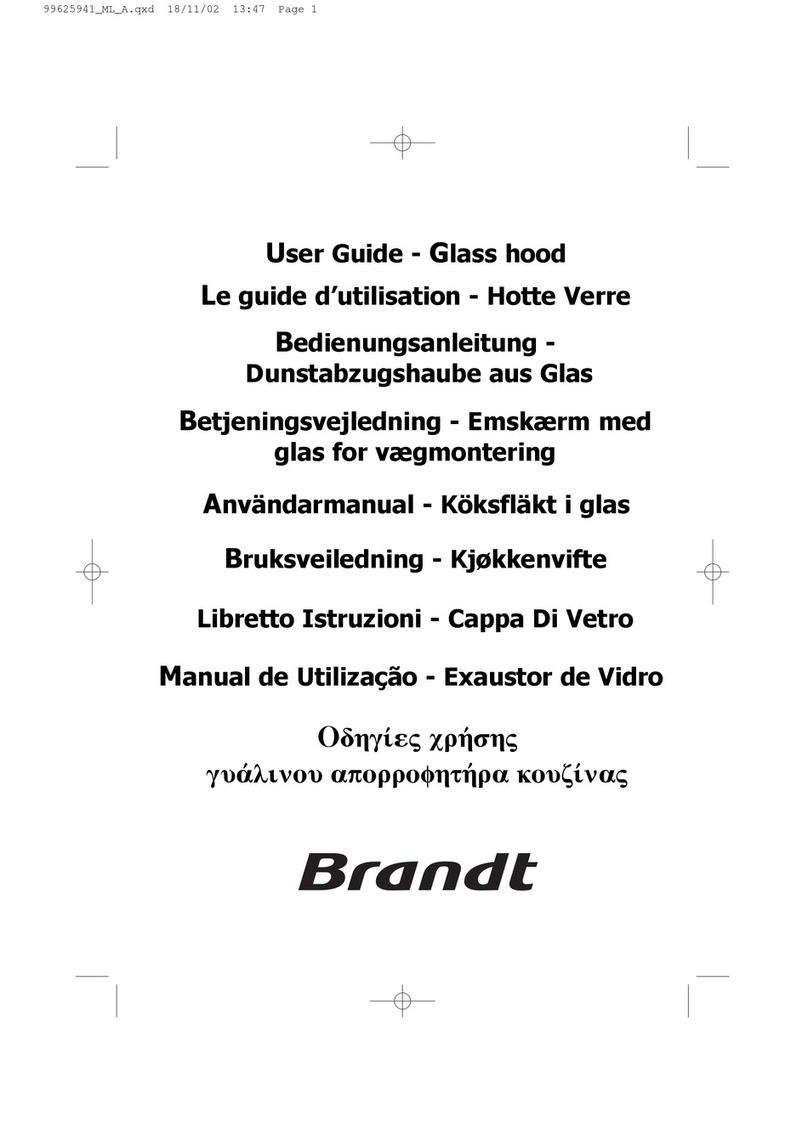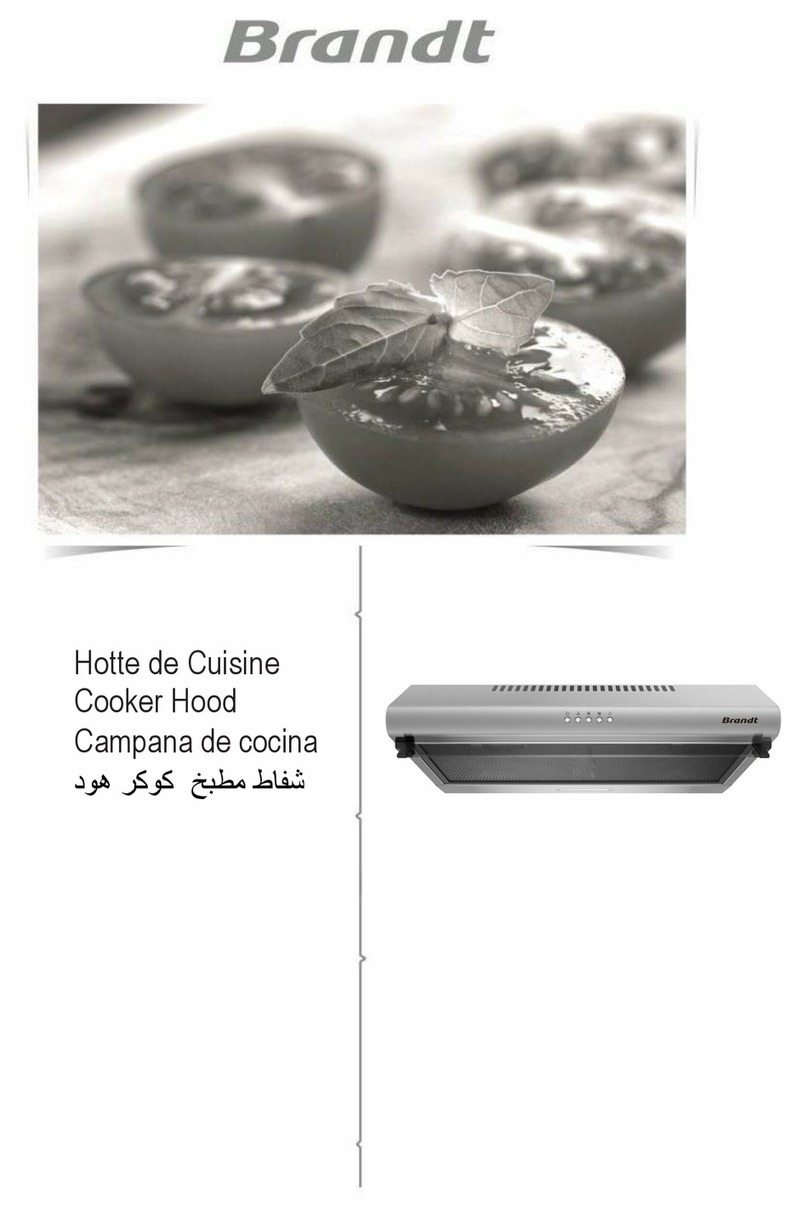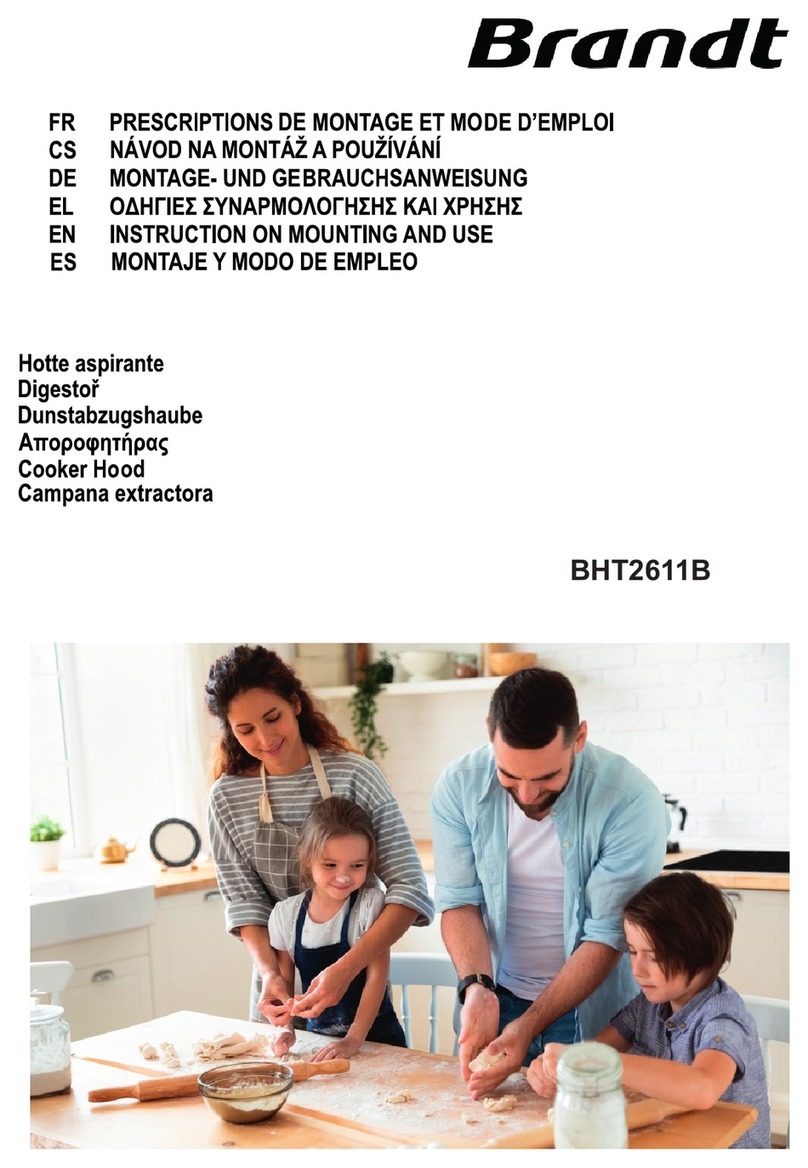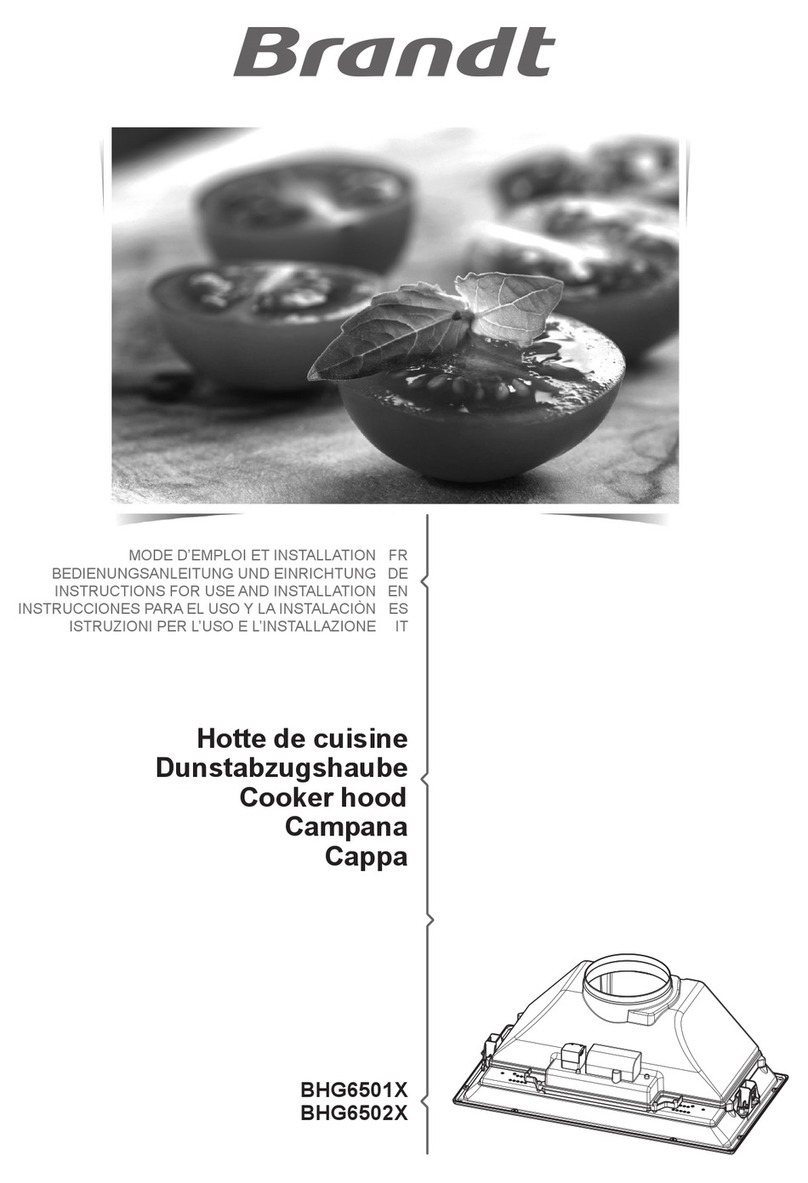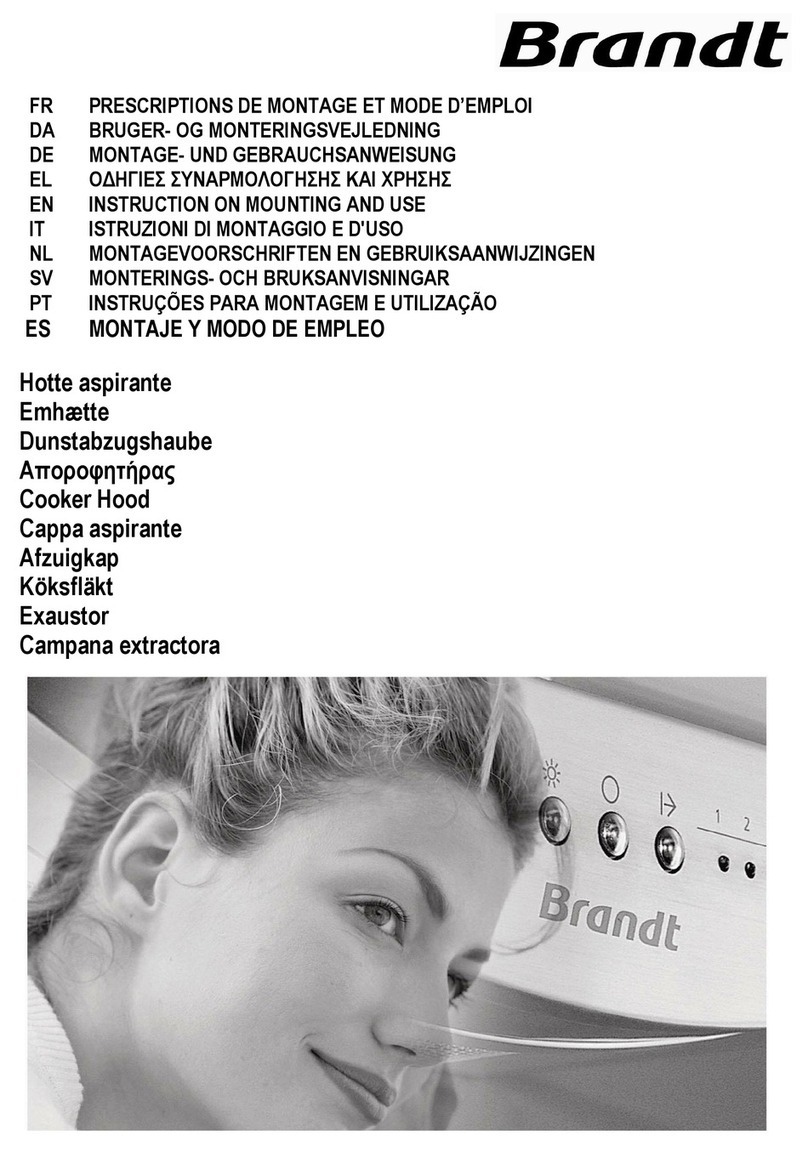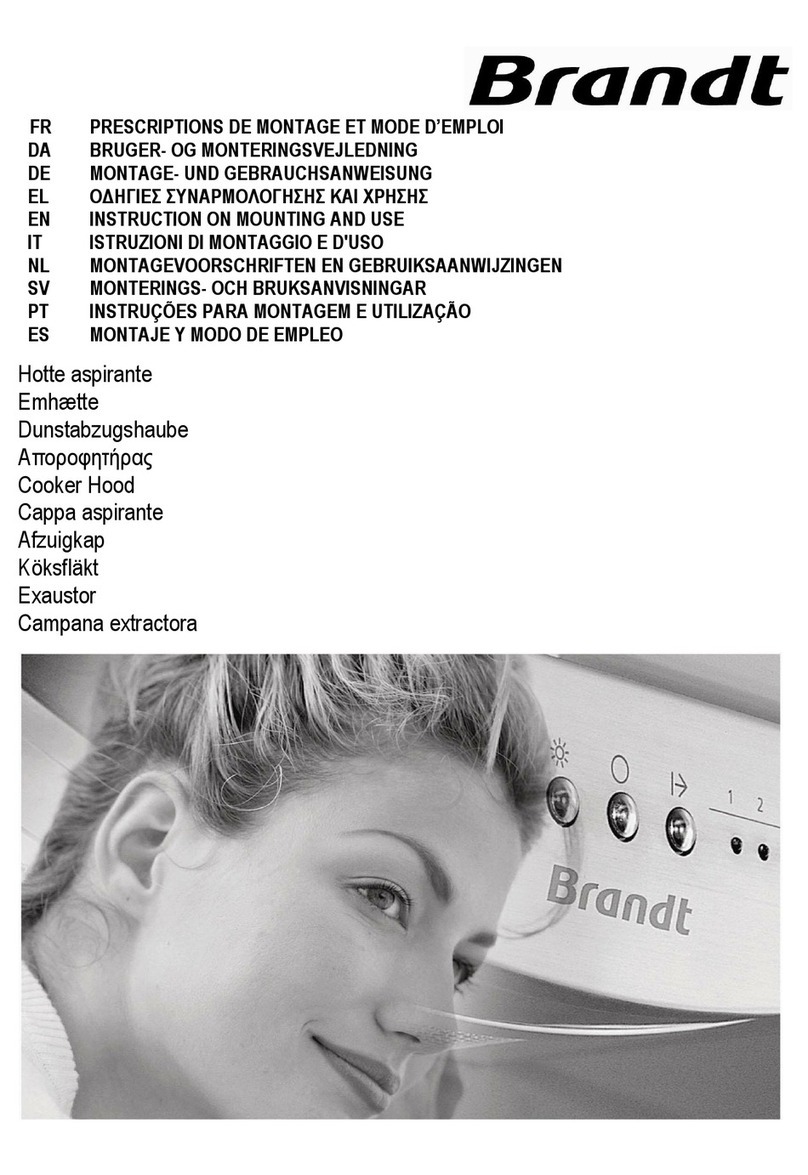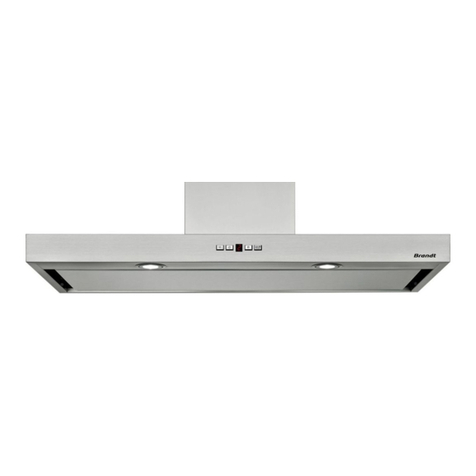WARNING
---------------------------------------------------
The distance between the hob and the lower
part of the hood must be at least 65 cm.
The air collected must not be conveyed into
a duct used to blow off smokes from ap-
pliances fed with an energy other than
electricity (central heating systems, ther-
mosiphons, water-heaters, etc.).
Comply with the official instructions provided
by the competent authorities in merit when
installing the disposal duct. In addition,
exhaust air should not be discharged into a
wall cavity, unless the cavity is designed for
that purpose.
The room must be well aerated in case a
hood and some other heat equipment fed
with an energy other than electricity (gas, oil,
coal heaters, etc) operate at the same time.
In fact the intake hood, disposing of air, could
create a vacuum in the room. The vacuum
should not exceed 0,04mbar. This prevents
the gas exhausted by the heat source from
being intaken again. It is therefore advisable
to ensure the room contains air taps able to
ensure a steady flow of fresh air.
This appliance has such technical parti-
culars that it belongs to class II in-
sulation, therefore it must not be earthed.
The following warning is valid in the United
Kingdom only:
As the colours of the wires in the mains lead
of this appliance may not correspond with
the coloured markings identifying the
terminals in your plug, proceed as follows:
– the wire which is coloured blue must be
connected to the terminal which is marked
with the letter N or coloured black;
– the wire which is coloured brown must be
connected to the terminal which is marked
with the letter L or coloured red;
– neither wire is to be connected to the earth
terminal of a three-pin plug.
When making the electrical connections,
check that the voltage values correspond to
those indicated on the data plate inside the
English
appliance itself.
In case your appliance is not furnished with
a non separating flexible cable and has no
plug, or has not got any other device ensu-
ring omnipolar disconnection from the elec-
tricity main, with a contact opening distance
of at least 3 mm, such separating device
ensuring disconnection from the main must
be included in the fixed installation.
Always switch off the electricity supply be-
fore carrying out any cleaning or servicing
operations on the appliance.
USE
---------------------------------------------------
Avoid using materials which could cause
spurts of flame (flambées) near the ap-
pliance.
When frying, take particular care to prevent
oil and grease from catching fire. Already
used oil is especially dangerous in this re-
spect. Do not use uncovered electric grates.
To avoid possible risks of fire always comply
with the indicated instructions when cleaning
anti-grease filters and when removing grease
deposits from the appliance.
MAINTENANCE
---------------------------------------------------
Thorough servicing guarantees correct and
long-lasting operation.
Use lukewarm water and neutral detergent
to clean painted appliances. Never use
products containing abrasives.
Take great care to prevent the use of corro-
sive or abrasive products when cleaning steel,
copper or brass appliances. It is advisable to
use specialized products according to the
manufacturer’s instructions.
vegetal charcoal fiber panel and recirculated
aroundtheroombythefrontfissures.ATTENTION:
Forthefilteringversionitisabsolutelynecessary
to use the special active vegetal charcoal fiber
panel whereas for the ducting version it is not.
INSTALLATION
--------------------------------------------------
Beforeassemblingtheapplianceitisnecessaryto
takeofftheanti-greasegrille.Totakeoffthegrill
itisnecessarytopushthisonetowardstherearof
theapparatus, bymeans ofthe properknobs, so
that it gets released, and to pull it downwards; to
take it off completely, make it rotate on one side
keepingthe other onesteady (Fig. 3).
Fortheductinginstallationoftheappliance,connect
one of the two discharge outlet to the external
ductingandsealtheotheropeningwiththesupplied
cap(Fig.4).Forthe filtering installationyoumust
closeboththedischargeoutletsoftheapparatus
usingthesupplied caps.
Thefollowingoperationsareessentialforassembly:
– Installa proper wiring system.
– If your apparatus is to be assembled as a
Ductingappliance,youmustfirstmaketheair
ventingholeandgetaproperpipetoconnect
thehole to theflange of thehood.
Wallfitting
Makinguseoftheappropriatedrillingjig,applythe
supplied blocks into the wall. Insert two of the
supplied screws so that the apparatus can be
hooked onto these ones by means of the holes
provided on the appliance (Fig. 5A). Once the
apparatus is hooked, fix it definitively to the wall
usingthetwootherscrewsandtheholesmadeat
its bottom (Fig. 5B). To avoid damage make
exclusiveuseoftheholesalreadypreparedonthe
hood.Maketheelectricalconnections.
Wallcupboardfitting
Usingtheappropriatedrillingjigmakethefourfixing
holesintothebottomofthewallcupboardandcut
theairventingholeifthehoodisaductingversion
one (for the filtering version this hole is not
necessary).Holdingthehoodagainstthebottom
ofthecupboardfixittoitbymeansofthesupplied
four screws (Fig. 6). Make the electrical
connections.
IMPORTANT:
CheckthepositionofscrewA(Fig.9).For the
ducting version screw A must be completely
screwed; for the filtering version the screw
mustbecompletelyunscrewedtoletthesucked
air to get out through the top fissures.
OPERATION
--------------------------------------------------
Thehoodsareprovidedwiththefollowingtypeof
controls:
Controls of Fig. 7:
A = light switch.
B = first speed motor ON/OFF switch.
C = second speed switch.
D = third speed switch.
E=warning light: indicatesmotoroperation.
Controls of Fig. 8:
A = light switch.
Position0: light off.Position 1: lighton
B = motor switch.
Position0:motoroff.Position1-2-3:motorfirst,
secondand thridspeed motoron.
C=warning light: indicatesmotoroperation.
Filtering/ductingconversion:
The conversion can be done in the inside of the
appliance.Accessispossiblebyopeningthegrille
as described beforehand. Verify that screw A
(Fig.9)iscompletelyunscrewed,sothattheinside
valvelettheairtobeconveyedagainintotheroom
throuththeslots.Inserttheactivatedcharcoalfiber
panel (Fig.2F and 9F): lift the two stops made of
metallic wire (Fig.9C); insert the fiber panel and
set back the two stops.
In case the hood is a filtering version one, it is
necessarytochangetheactivatedcharcoalfiber
panel(Fig.2Fand9F)accordingtoutilizationabout
every six month. To remove the fiber panel:
– take off the anti-grease grill: by means of the
proper knobs make the grill move towards
the rear of the apparatus and drop the front
part of it; now, keeping the right (or left) side
of the grill steady, make the opposite side
rotate so that it gets off the hood (Fig.3).
– lift the two metallic stops (Fig. 9C).
– removethefiberpanel.
Theanti-greasefilteringpaneliseasilyremoved
from the grille by opening it as described above
and lifting the two stops made of metallic wire
(Fig.9C). In the filtering version, to get access to
theanti-greasepaneltheactivatedcharcoalfiber
panelmustberemovedtoo.Changetheanti-grease
panel according to use. If the panel is a metallic
oneitcanbewashedwithsomeneutraldetergent
by hand or in a dish-washer.
To gain access to the light bulb(s), remove the
anti-greasegrill asdescribed aboveandremove
thebulb(s).Replacewithlampsofthesametype.
DESCRIPTION
--------------------------------------------------
TheappliancecanbeusedbothinDuctingversion
andFilteringversion.
In the Ducting version (Fig. 1), cooking vapours
and/orodoursareconveyedstraightoutside(ceiling
and/orwall)byadisposalduct,usingtheholesthat
are predisposed on the top and/or at the back of
theapparatus.
In the Filtering version (Fig. 2) cooking vapours
and/orodoursaredepuratedbyaspecialactivated

